问题
最近在深度使用tarojs-plugin-solid插件去写小程序的项目,发现了一些bug,也在仓库的issues中记录了下来,这2个bug的实质也算殊途同归,都是h函数出现了问题。
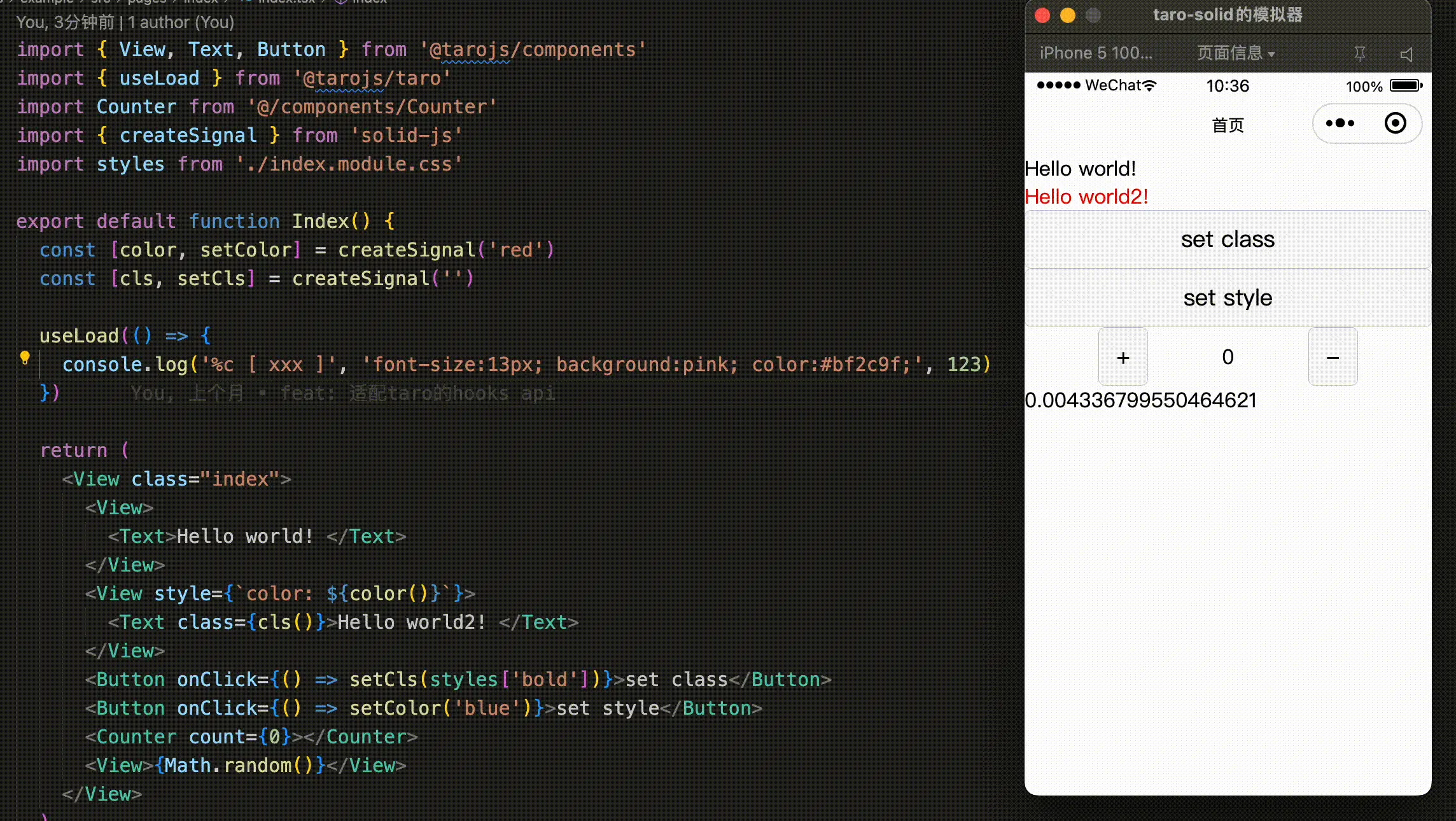
不过图片所示的问题更加严重,这会在父组件中props的signal更新时,带动子组件的全量更新,这明显是违背了solid更新的原则。
问题分析
上菜:
import { View, Text, Button } from '@tarojs/components'
import Counter from '@/components/Counter'
import { createSignal } from 'solid-js'
import styles from './index.module.css'
export default function Index() {
const [color, setColor] = createSignal('red')
const [cls, setCls] = createSignal('')
return (
<View class="index">
<View>
<Text>Hello world! </Text>
</View>
<View style={`color: ${color()}`}>
<Text class={cls()}>Hello world2! </Text>
</View>
<Button onClick={() => setCls(styles['bold'])}>set class</Button>
<Button onClick={() => setColor('blue')}>set style</Button>
<Counter count={0}></Counter>
<View>{Math.random()}</View>
</View>
)
}
示例代码长得如此俊俏,却表里不一,实属把我给伤透了心。在set style操作后,会去设置color,而绑定color的响应式数据只存在一处,就是<View style={color: ${color()}}>,但是当我们设置了后,最下面的{Math.random()},也会重新render,count也会重置为0,这个操作看起来就有点类似重新init了。当我把color的响应式数据绑在text中时,他表现的结果又是符合预期的。
<View>
<Text class={cls()} style={`color: ${color()}`}>Hello world2! </Text>
</View>
那么到底为什么出现这种情况呢?在经历了一轮debug定位后,我发现在setter触发后的更新,他更新的依赖存在多个value。
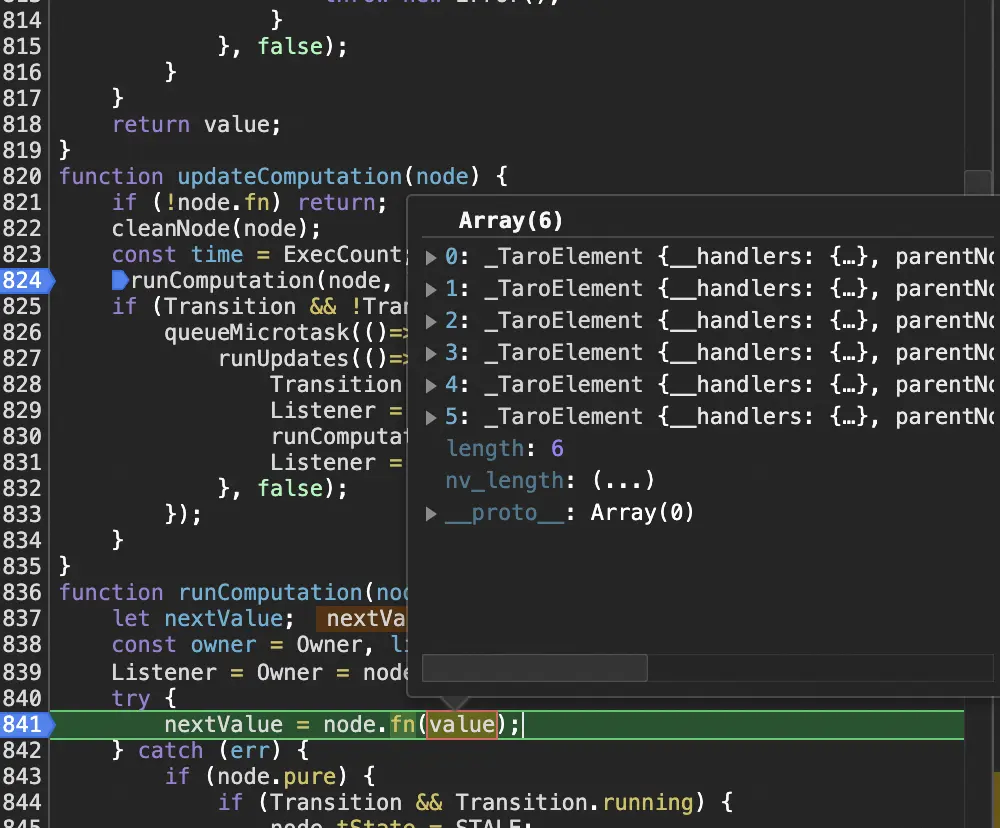
而这其中的value数组,都是需要更新的dom,那为啥他会将这些无需更新的dom都推入到了observers呢?
solid编译结果
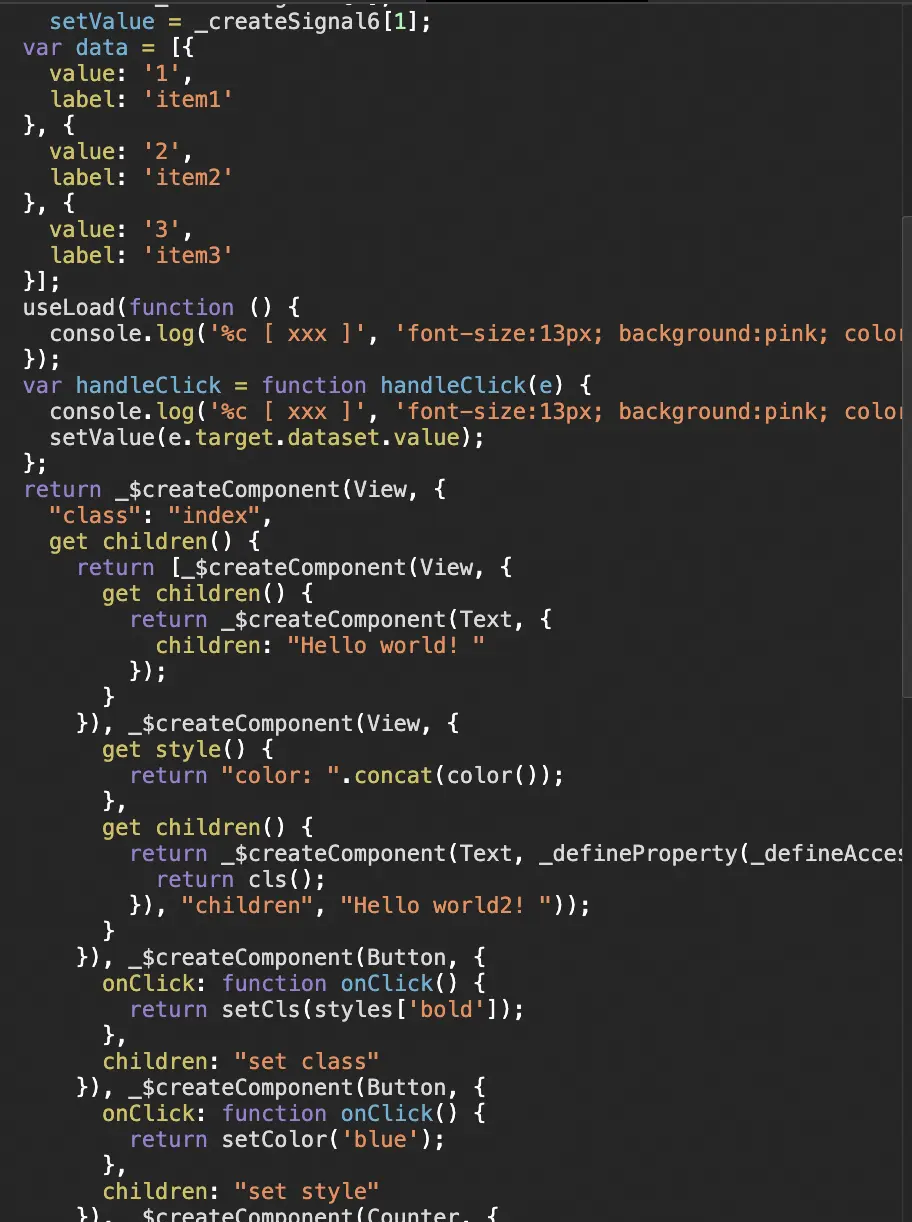
这个编译结果,起初并没有看出有多大的问题,随着debug的深入,发现有重复触发依赖收集getter。
// h.ts
// 处理children
if (Object.prototype.hasOwnProperty.call(props, 'children')) {
const descriptor = Object.getOwnPropertyDescriptor(props, 'children')
if (descriptor?.get) {
children = solidChildren(() => props.children)
} else {
children = props.children
}
}
重点就出在solidChildren,这个是solidjs引入的children函数,而children函数内部也有getter。
export function children(fn: Accessor<JSX.Element>): ChildrenReturn {
const children = createMemo(fn);
const memo = "_SOLID_DEV_"
? createMemo(() => resolveChildren(children()), undefined, { name: "children" })
: createMemo(() => resolveChildren(children()));
(memo as ChildrenReturn).toArray = () => {
const c = memo();
return Array.isArray(c) ? c : c != null ? [c] : [];
};
return memo as ChildrenReturn;
}
这就造成了,只要父级的props有更新,都会触发children的更新,也就造成了页面像是初始init一样。
解决小程序组件编译
在编译小程序的view标签时,在jsx中写法是通过import taro的View组件进来编译的,而在solid侧,会将其作为组件进行编译,咋一看之下,并没有多大毛病,起初我也是遵守这jsx的写法进行solid与taro的融合,自己写了个h函数去编译这个View组件。在编译View组件的时候,其实他并不是function,而是string:‘view’,所以需要联合createElement,及setProps对其特殊处理,但是这么做就脱离了solid的一套自循环响应式系统了,这也是造就一切问题的原因所在。
我们看看solid-playground中编译普通标签的编译结果:
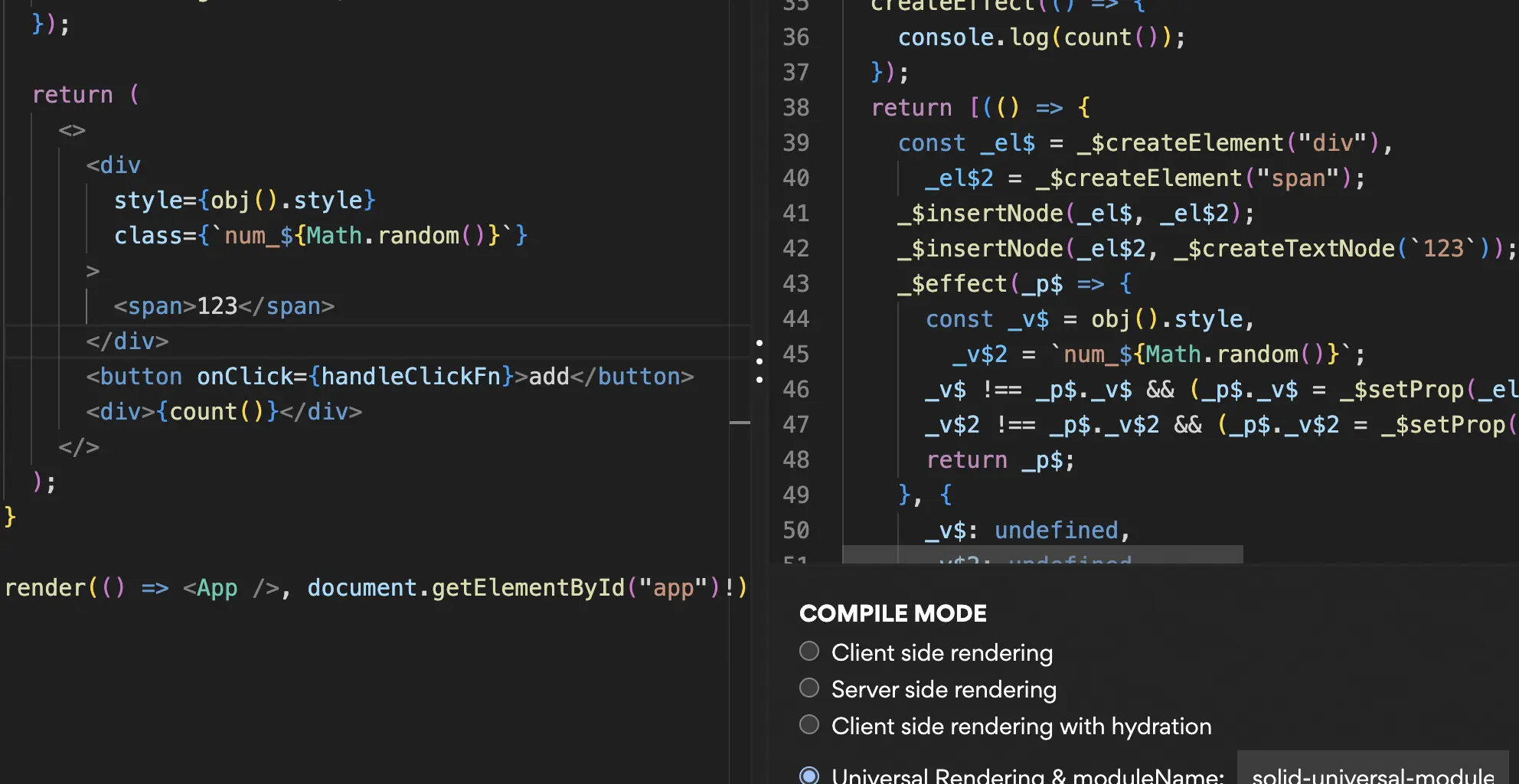
可以看到在编译div标签时,使用_$createElement进行编译,而我们的View组件他本质就是一个view标签,所以当我们不再使用这种组件形式进行编译,改为自定义标签书写,发现他竟然真能顺利编译成功,并且响应式也是正常的。怪不得solid中并没有这种h函数去处理你的custom-render,当然官方也有个h函数,但是那个h函数在创建的时候,需要的参数,在微信小程序中并没有这些环境。
顺利删掉h函数,感觉一切都变清晰了很多!
解决自定义标签在solid的ts定义
在solid的tsc中,我们是使用solid-js进行编译标签的,而对于小程序的标签,solid是没有定义的,这就造成了标签爆红:
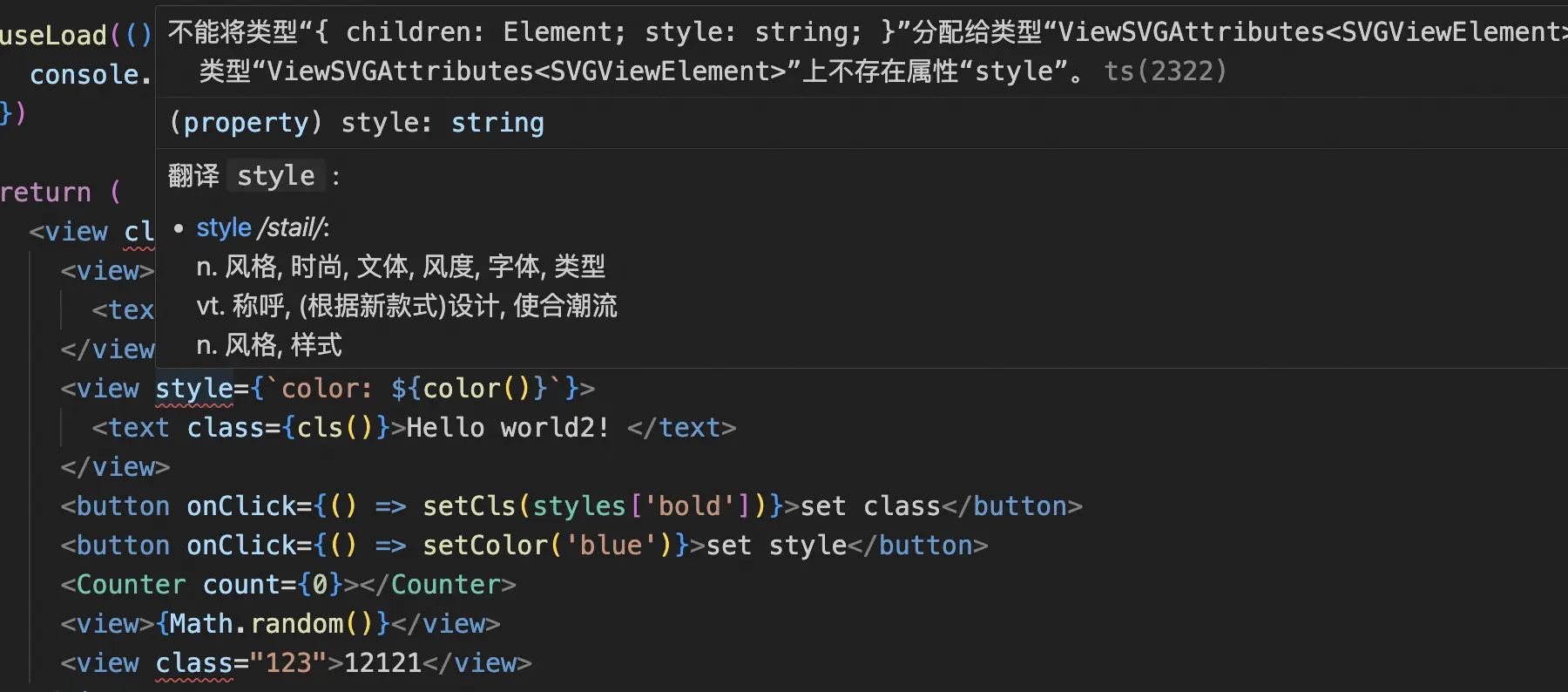
这对于强迫症患者来说肯定很不适应,所以我们还得将这份类型给加上,而查了一番资料,在solid的issues中也能看到有类似的需求,也能看到的解决方案:
declare module "solid-js" {
namespace JSX {
interface IntrinsicElements {
view: TransformReact2SolidType<ViewProps>
}
}
}
这里也跟taro提供的ViewProps关联上,这样在写view之类的小程序标签也就能获得类型提示了,这份文件需要在项目引入一下,可以在global.d.ts:
/// <reference path="../node_modules/tarojs-plugin-solid/types/taro-components-solid.d.ts" />
改造tsc
{
"compilerOptions": {
"target": "es2017",
"module": "commonjs",
"removeComments": false,
"preserveConstEnums": true,
"moduleResolution": "node",
"experimentalDecorators": true,
"noImplicitAny": false,
"allowSyntheticDefaultImports": true,
"outDir": "lib",
"noUnusedLocals": true,
"noUnusedParameters": true,
"strictNullChecks": true,
"sourceMap": true,
"rootDir": ".",
"jsx": "preserve",
"jsxImportSource": "solid-js",
"allowJs": true,
"resolveJsonModule": true,
"esModuleInterop": true,
"noEmit": true,
"isolatedModules": true, // 解决掉自定义的type与solidjs定义的冲突
"typeRoots": ["node_modules/@types"],
"baseUrl": ".",
"paths": {
"@/*": ["src/*"]
}
},
"include": ["./src", "./types", "./config"],
"compileOnSave": false
}
总结
经过开发这次tarojs-plugin-solid插件,与普通的业务代码不同,关注的点不再是上层ui层,还深入到了taro,solidjs源码中查看,要读懂源码,最好的办法就是去参与其中。经过这次的深度使用并解决的问题,迎来的是一个稳定的版本。之前还有老哥给我留言,能否上生产,当时我信心不足,但是这次给我带来很大的信心,毕竟这一块当时写的也是有疑惑的。所以如果对于solidjs感兴趣的,又想运用到小程序中(目前仅支持小程序,h5还是用原生吧),欢迎大家使用🙏🙏🙏仓库。
原文链接:https://juejin.cn/post/7342148728135319564 作者:phy_lei
